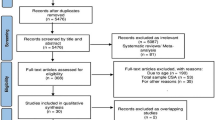Abstract
Purpose
Childhood sexual abuse (CSA) is widespread amongst South African (SA) children, yet data on risk factors and psychiatric consequences are limited and mixed.
Methods
Traumatised children and adolescents referred to our Youth Stress Clinic were interviewed to obtain demographic, sexual abuse, lifetime trauma and psychiatric histories.
Results
Data for 94 participants (59 female, 35 male; mean age 14.25 [8.25–19] years) exposed to at least one lifetime trauma were analysed. Sexual abuse was reported in 53% of participants (42.56% females, 10.63% males) with 64% of violations committed by perpetrators known to them. Multinomial logistic regression analysis revealed female gender (P = 0.002) and single-parent families (P = 0.01) to be significant predictors of CSA (62.5%). CSA did not predict exposure to other traumas. Sexually abused children had significantly higher physical and emotional abuse subscale scores and total CTQ scores than non-abused children. Depression (33%, X 2 = 10.89, P = 0.001) and PTSD (63.8%, X 2 = 4.79, P = 0.034) were the most prevalent psychological consequences of trauma and both were significantly associated with CSA.
Conclusions
High rates of CSA predicted high rates of PTSD in this traumatised sample. Associations we found appear consistent with international studies of CSA and, should be used to focus future social awareness, prevention and treatment strategies in developing countries.
Similar content being viewed by others
References
Bolen RM (2001) Child sexual abuse: its scope and our failure. Kluwer Academic/Plenum Publishers, New York
Boney-McCoy S, Finkelhor D (1995) Prior victimization: a risk factor for child sexual abuse and for PTSD-related symptomatology among sexually abused youth. Child Abuse Negl 19:1401–1421
Brown J, Cohen P, Johnson JG, Salzinger S (1998) A longitudinal analysis of risk factors for child maltreatment: findings of a 17-year prospective study of officially recorded and self-reported child abuse and neglect. Child Abuse Negl 22:1065–1078
Collings SJ (1991) Childhood sexual abuse in a sample of South African university males: prevalence and risk factors. S Afr J Psychol 21:153–158
Collings SJ (1997) Child sexual abuse in a sample of South African women students: prevalence, characteristics, and long-term effects. S Afr J Psychol 27:37–42
Dube SR, Anda RF, Felitti VJ, Croft JB, Edwards VJ, Giles WH (2001) Growing up with parental alcohol abuse: exposure to childhood abuse, neglect, and household dysfunction. Child Abuse Negl 25:1627–1640
Fergusson DM, Horwood LJ, Lynskey MT (1996) Childhood sexual abuse and psychiatric disorder in young adulthood: II. Psychiatric outcomes of childhood sexual abuse. J Am Acad Child Adolesc Psychiatry 35:1365–1374
Finkelhor D, Baron J (1986) High-risk children. In: Finkelhor D (ed) A sourcebook on child sexual abuse. Sage, Beverly Hills, pp 60–88
Finkelhor D, Hotaling G, Lewis IA, Smith C (1990) Sexual abuse in a national survey of adult men and women: prevalence, characteristics, and risk factors. Child Abuse Negl 14:19–28
Fleming J, Mullen P, Bammer G (1997) A study of potential risk factors for sexual abuse in childhood. Child Abuse Negl 21:49–58
Glaser D (2000) Child abuse and neglect and the brain—a review. J Child Psychol Psychiatry 41:97–116
Glaser SH, Prior V (1997) Is the term child-protection applicable emotional abuse? Child Abuse Rev 6:315–329
Herman J, Hirschman L (1981) Families at risk for father-daughter incest. Am J Psychiatry 138:967–970
Kaufman J, Birmaher B, Brent D, Rao U, Flynn C, Moreci P, Williamson D, Ryan N (1997) Schedule for affective disorders and schizophrenia for school-age children-present and lifetime version (K-SADS-PL): initial reliability and validity data. J Am Acad Child Adolesc Psychiatry 36:980–988
Levett A (1989) A study of childhood sexual abuse among South African university women students. S Afr J Psychol 19:122–129
Lipschitz DS, Rasmusson AM, Anyan W, Cromwell P, Southwick SM (2000) Clinical and functional correlates of posttraumatic stress disorder in urban adolescent girls at a primary care clinic. J Am Acad Child Adolesc Psychiatry 39:1104–1111
Madu SN (2001) The prevalence and patterns of childhood sexual abuse and victim-perpetrator relationship among a sample of university students. S Afr J Psychol 31:32–37
Madu SN, Peltzer K (2000) Risk factors and child sexual abuse among secondary school students in the Northern Province (South Africa). Child Abuse Negl 24:259–268
McCloskey LA, Bailey JA (2000) The intergenerational transmission of risk for child sexual abuse. J Interpers Violence 15:1019–1035
Paveza GJ (1988) Risk factors in father-daughter child sexual abuse: a case-control study. J Interpers Violence 3:290–306
Shah RZ, Dail PW, Heinrichs T (1995) Familial influences upon the occurrence of childhood sexual abuse. J Child Sex Abus 4:45–61
Silva RR, Alpert M, Munoz DM, Singh S, Matzner F, Dummit S (2000) Stress and vulnerability to posttraumatic stress disorder in children and adolescents. Am J Psychiatry 157:1229–1235
Tebbutt J, Swanston H, Oates RK, O’Toole BI (1997) Five years after child sexual abuse: persisting dysfunction and problems of prediction. J Am Acad Child Adolesc Psychiatry 36:330–339
Vogeltanz ND, Wilsnack SC, Harris TR, Wilsnack RW, Wonderlich SA, Kristjanson AF (1999) Prevalence and risk factors for childhood sexual abuse in women: national survey findings. Child Abuse Negl 23:579–592
Walrath C, Ybarra M, Holden EW, Liao Q, Santiago R, Leaf P (2003) Children with reported histories of sexual abuse: utilizing multiple perspectives to understand clinical and psychosocial profiles. Child Abuse Negl 27:509–524
Acknowledgement
This study was supported by the Medical Research Council of South Africa.
Author information
Authors and Affiliations
Corresponding author
Rights and permissions
About this article
Cite this article
Carey, P.D., Walker, J.L., Rossouw, W. et al. Risk indicators and psychopathology in traumatised children and adolescents with a history of sexual abuse. Eur Child Adolesc Psychiatry 17, 93–98 (2008). https://doi.org/10.1007/s00787-007-0641-0
Accepted:
Published:
Issue Date:
DOI: https://doi.org/10.1007/s00787-007-0641-0



